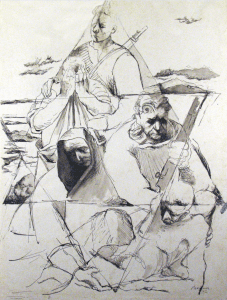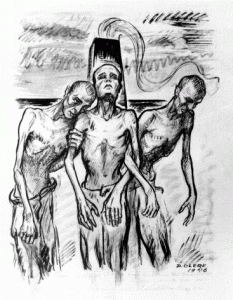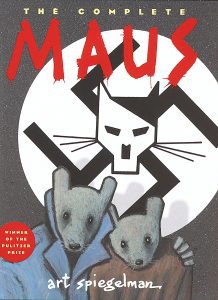The Importance of Art During and After the Holocaust – Loss and Affirmation: Illustrations and Drawings by William Pachner
Zoe Wright, Public Relations Intern
The Florida Holocaust Museum is excited to announce the opening of the exhibition, Loss and Affirmation: Illustrations and Drawings by William Pachner. The exhibition is opening on July 27, 2019 and will be open to the public through January 5, 2020.
This collection was donated in 2016 by Pachner’s children, Anne and Charles Pachner. The works are markedly different than those by the artist already held and exhibited by the Museum and were painted during World War II and in the years immediately following.
William Pachner was born in Moravia, Austro-Hungarian Empire (later Czechoslovakia) in 1915. He left his home and family to pursue a career in commercial illustration in the United States in 1939 only a few days before the Nazis occupied Czechoslovakia.
Pachner moved to Chicago and became the art director at Esquire Magazine. When America entered World War II, he felt compelled to take a more active part in the war effort and left his position to enlist in the army but was rejected. Instead of returning to the magazine, Pachner devoted himself to free-lance antifascist illustrations for Colliers, Cosmopolitan, and other popular magazines of the day.
When the war ended in 1945 and he received confirmation that his parents and brother were murdered, Pachner said: “Never again will my hand be hired. From now on, I shall use whatever gifts I have to bear witness to my experience.” With a family to support, he left the well-paid world of commercial art and became a studio artist.
Pachner believed that his art should be relevant to what was going on in the world around him. He said, “I want my art to reflect our human experience in the world in its totality, the beautiful as well as the atrocious, the tender and caring as well as the insensitive and murderous.”

Turning to his work, Pachner used pen and paper, paint and canvas to communicate his grief and his reaction to man’s inhumanity to man. The artworks made during the period directly following the war convey feelings of despair, anger and bitterness. Following these, his work focused on human connection, comfort, and affirmation.
Pachner also has a strong connection to the Tampa Bay area. In 1951, he was invited to teach art by Mrs. Shillard Smith, founder of the Florida Gulf Coast Art Center. In 1954, Pachner had a one-man exhibition at the Ringling Museum in Sarasota. Taking a liking to the area, Pachner began to teach at the Tampa Art Institute during the winter term from 1957 through 1969. Then, he went on to establish the William Pachner Workshop in Clearwater. Pachner went on to have many one-man exhibitions in Tampa Bay, including at the Arts Center and the Museum of Fine Art in St. Petersburg, just down the street from The Florida Holocaust Museum. From teaching to sharing his craft, Pachner’s contribution to the arts in Tampa Bay has been immense.
Pachner, like many artists during the Holocaust used his art to give a voice to the atrocities that where around him. Likewise, after the Holocaust artists created art to memorialize victims and help ensure this horrific event would never be forgotten. The types of artwork and medium was all very different, as people react to horror in different ways.
For instance, artist and Holocaust survivor, David Olère sketched to provide a testimony to all the people who died in the concentration camps. Olère was interned at Auschwitz. He worked as a Sonderkommando, which was the unit responsible for emptying remains from gas chambers. As he experienced the concentration camps himself, Olère features himself as the “lone witness” in his sketches. The ghostly face watches the terrible scenes he depicts, that cannot be erased from his memory.

In contrast, other artists use comics as a form of remembrance, like Art Spiegelman, an American cartoonist. Spiegelman interviewed his father about his experiences as a Polish Jew and Holocaust survivor. He retold the experience of his father as a graphic novel, Maus. Spiegelman characterized the Jews in the novel as mice and the Nazis as cats. Cats and mice are natural enemies. The Nazi cats found no fault in the systematic killing of the Jewish mice. This artistic choice is also based on historical quotes, as Nazis called Jewish people the “vermin of society.” Spiegelman’s choice to draw the Jewish people as mice demonstrates the dehumanization and the dignity stripped from them. Because Maus is a graphic novel, the pictures can speak a thousand words to the audience as the pictures capture the emotions very well.

Holocaust art is considered documentary art because it tells the stories of those who were stripped of their voice. Art has always stood to comment on the social climate and events. No matter how big or small, tragic or happy, art is used for people to express their emotions. The Holocaust was no different. Today, it is important to engage and understand the art that was created during and after the Holocaust. Art helps keep history alive. The Holocaust was a horrific event we must never forget and art acts as an aid to help remember.
To learn more about Pachner and other artists during or after the Holocaust, come visit The Florida Holocaust Museum. Be sure to mark this exhibition in your calendars.
This exhibition opens to the public on July 27, 2019 and will be on view through January 5, 2020.
